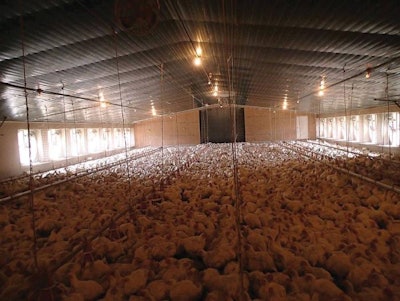
Research conducted on commercial broiler farms in Georgia is providing some interesting data on how light levels in the house can impact bird activity and body temperature in warm weather months.
Dr. Brian Fairchild, professor, poultry science, University of Georgia, told the audience of the WATT Global Media webinar, "Managing broilers in hot weather," that broiler lighting programs seldom call for more than eight hours of dark in a 24-hour period. Most provide between two and eight hours of darkness in the house, depending on the age of the birds, with many calling for only two hours of darkness per day in the week prior to marketing the birds.
More light intensity is provided in the house during the brooding period, the first week or two after placement, and then the lights are dimmed down as the birds get older, sometimes to as little as 0.01 foot candles of light.

The light coming in from the tunnel fan openings, not the artificial lighting in the house, can be perceived as sunrise by the birds.
Broilers tend to sit down and rest at nightfall. This can be demonstrated by tracking the water consumption in the house. Water and feed consumption are very highly correlated, and water consumption ceases during dark intervals in the house, according to Fairchild.
But, in houses with light intensities as low as 0.01 foot candles, the researchers noticed something odd: Based on water consumption and bird body temperature data, up to 80 percent of the birds were reacting to the natural sunset and sunrise outside the broiler house. The light coming in from the tunnel fan openings was perceived as sunrise by the birds, not the artificial lighting in the house. This meant that market-age broilers were in effect getting as much as 12 hours of “darkness” per 24-hour period instead of the two hours expected based on the lighting program.
Mike Czarick, agricultural engineer, University of Georgia, said that when near-market age broilers sit during dark intervals in the house, they don’t eat and drink, but they also don’t cool off. A standing bird has more of its body exposed to the high-velocity air moved through the house by the tunnel fans. Even with evaporative cooling, most of the temperature lost from the birds is due to air movement, Czarick said.
To make sure birds are responding to the day length we want them to, Fairchild and Czarick recommended not using light intensities below 0.1 foot candles. They also recommended not having the lights-out time in the broiler house before midnight during hot weather, so that the birds will be standing up and moving around for a few hours after the sunset outside the house. This will allow body temperatures to cool down before the birds rest in darkness.


















